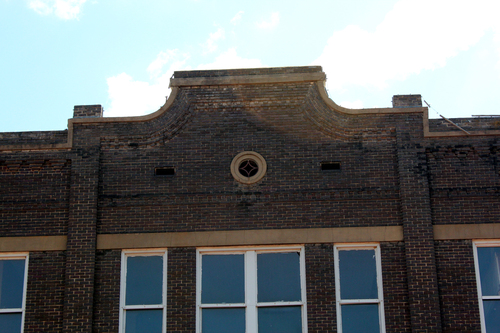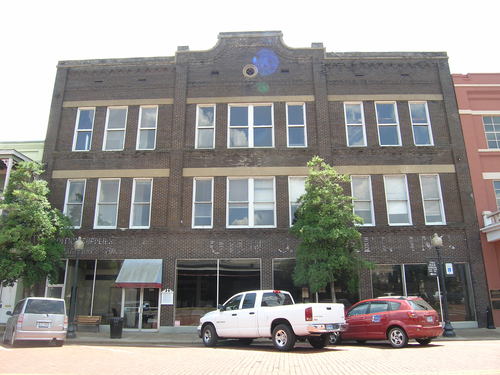204 E. Pilar Photographs
204 E. Pilar 2010 Survey Information
Click here for the 2010 survey form.204 E. Pilar 2007 National Register Information
- Address: 204 E. Pilar
- Name: Story-Wyatt Office Supply
- Previous Name: Mahdeen's / Wyatt's Office City
- Date: 1918
- Type: Two part
- Contributing: Yes
This three-story building is constructed of brown brick, made locally on banks of Banita Creek. The symmetrical façade is divided into three bays; the central bay is slightly wider than the outer two, and features a stepped parapet. The vertical bays are delineated by pilasters, which extend from the second floor upward to the parapet. This building is given horizontal accent by a band of buff-colored stone (or concrete) that externally demarcates the interior floor division. These bands are broken at each pilaster, but otherwise run the length of the bay. Decorative details are limited to triangulated, corbelled brickwork beneath the banks of windows, the same brickwork at the parapet, and a single decorative medallion adorning the cornice. The ground floor storefront is composed of an off-set double entry, flanked by plate-glass display windows framed in aluminum. The upper windows are equally sized, 1/1 wood sash. In the east and west bays, fenestration patterns are symmetrical, with three evenly-spaced sash windows per bay. The pattern of the central bay slightly different, consisting of a paired sash window flanked by single windows (For a pattern of 1/2/1). The composition of this building is simple and straightforward, contributing to its sense of mass and repose. Original, intact interior details include: woodwork; doors; office cabinets; large oak vats in which Mahdeen tonic was mixed on the third floor (which has high ceilings to accommodate the machinery); and a ramp that was used to transport automobiles from the first to the second floor.
The Mahdeen Company, which operated from 1912 to 1985, originated from John Lewis Needham's bathtub. Needham, a local barber, had developed a hair tonic and dandruff remedy for use his shop at corner of Main and Pecan (the later home of Pool Pharmacy). Around 1907, he began to mix and bottle the liquid from his home, with the intention of selling the concoction throughout East Texas and Louisiana 250 Soon after, he met Frank Aikman, a traveling salesman out of New York who sold Dodson's Livertone. Aikman was often in Nacogdoches and the surrounding region (he stayed at the Redland Hotel) for sales calls, and upon learning of Needham's formula quickly recognized the potential for its sale. Aikman and Needham formed a partnership, and founded the Mahdeen Company (Needham spelled backwards) on 12 September 1912. By January 1913, with Aikman supplying funding for expansion, they were in business. When Needham died in 1918, Aiken acquired control of the company. Shortly thereafter, he took up residence in a new brick building designed by Rulfs on the south side of the square. The building had been commissioned by Eugene H. Blount and Thomas E. Baker, and though Mahdeen was the tenant for years, it was known as the Blount-Baker Building into early 1900s.
The Mahdeen Company occupied the basement and the third floor, which housed the vats for mixing and bottling the tonic. The first and second floor of this building were used by auto dealerships such as Duke H. Herbert Ford Co, and Ben T. Wilson Chevrolet. In its new facility, the company was quite successful, earning over a million dollars in this era Mahdeen's profits allowed Aikman to make various philanthropic gifts to city of Nacogdoches: he contributed a great deal of funding for the construction of the Westminster Presbyterian Church on North Street; and in 1924 donated $12,000 for the erection of the Aikman Gymnasium on the Stephen F. Austin College campus. Aikman died in 1939, and the Mize Brothers (with partners E.C. Best and R.G. Muckleroy. Sr.) acquired Mahdeen in late 1939 or early January 1940. Muckleroy was bought out in 1941, leaving Mahdeen in the hands of the Mize partnership. World War II threatened materials and supplies - Mahdeen's secret recipe included several ingredients imported from Europe - but the company continued to grow. Shortly after the acquisition, the Mize Brothers and Best introduced a new product, the Mahdeen Shampoo, which outsold the tonic. After 1940, Mahdeen products were distributed nationwide to wholesale establishments and to the armed forces overseas. It never had an extensive marketing campaign, but still sold rather well, particularly in California and to the United States Army and Navy. The packaging remained remarkable consistent over the long life of the tonic and shampoo; the bottle changed only once, and the label was slightly altered due to legal complications stemming from Aikman's use of an unauthorized photo of the daughter of an original employee. Because the images was used without a release, the label was modified to show a generic drawing of a woman). In October 1965, the Daily Sentinel announced that the "city's oldest industry" was sold to Owen Laboratories and would be moved to Dallas. EC Best, the partner in Mize Department store, remarked that he and Mize were "getting old," and received a lucrative offer from Owen. The building on Pilar Street was vacated, making way for the Village Furniture Store of Lufkin in the 1960s. In 1971, John S. Wyatt purchased the property from the Baker and Blount heirs to house Wyatt's Office City. The building is currently home to Story-Wright Office Supply.
204 E. Pilar 1986 Survey Information
- Address: 204 E. Pilar
- Date: 1918
- Block: 23
- Lot: 2
- Condition: Good, some alterations
- Description: 3-story rectangular brick commercial structure with load bearing walls and timber infrastucture; four bays at street level, apparently altered; 1/1 double-hung windows at levels 2 and 3; plate glass windows and doors at street level; decorative parapet rises above dentiled cornice and decorative string course; banding above windows. On the third floor chamfered columns measure 11.5 inches in width. At the first and second floors there are wood and a few metal pipe columns; two chimney's on the east side vented the wood burning stoves in the building. On the third floor, wood flooring and beaded wood ceiling are still intact, some plaster remains on the walls. Toward the front of the building there is an original wood frame stair to the second floor; at the rear of the building is an enclosed stair from the second to third floors; an early elevator is intact at the rear of the building, however it is no longer in use. At the second floor, the early car dealership offices are partially intact varnished wood with patterned glass office partitions and doors, some early cypress panel doors with ornate hardware are also intact On the third floor some remains of the Mahdeen Company's tonic and shampoo works are intact, including wood and metal vats, plumbing and electrical wiring. On the west side near the front is a mezzanine office with counters. The windows on the building are 1/1 wood double hung on the north facade, 2/2 and 4/4 with arched upper lights on the east and south.
- Significance: Shown on the 1912 Sanborn Fire Insurance Map as the site of Nacogdoches County Courthouse. After new courthouse was constructed at North and Main Streets, this 3-story brick building was erected in 1918 with elevator at rear; occupied by Mahadeen Company, a hair tonic and shampoo company founded by a banker named Needaham (Mahadeen is his name spelled backwards). His formulas were patented and sold in the United States and Europe. A prosperous financial backer helped Needham to develop his products. The business occupied the third story of this structure; there are still wood and metal vats associated with Mahadeen on the third floor. The building also housed Ford and Chevrolet auto dealerships, a furniture store, and an office supply store. The top sash on the third floor windows had Mahadeen spelled out until a few years ago.

_rdax_375x500.JPG)
